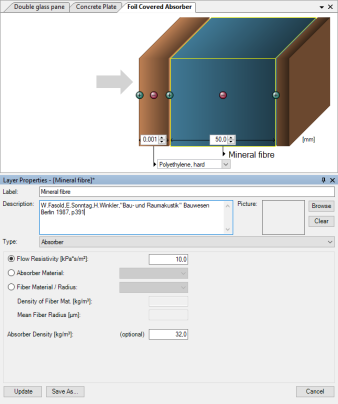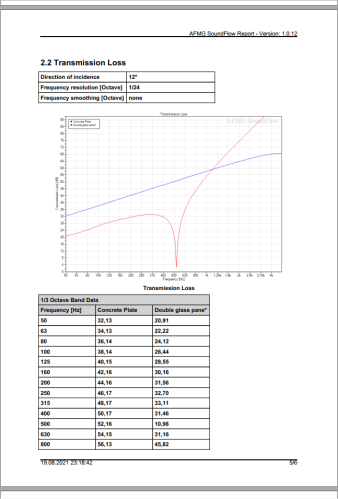AFMG SoundFlow - Tool for Acoustic Design of Multi-Layer Structures
Software
SoundFlow is a simulation software for calculating the absorption, reflection, and transmission of sound by multi-layer structures.
The software enables the modeling of wall, floor and ceiling structures by specifying layer materials and thickness.
Various calculation parameters can be defined and the graphic results display the frequency dependent absorption and reflection coefficients as well as the transmission loss, the complex input impedance and other acoustical measures.
The calculation engine is an accurate implementation based on the theory of sound absorbers developed by Mechel, Bies and others. You can choose between various computational models including the calculation according to the ISO 12354 standard.
Note, however, that the current software version does not support glued or laminated layers, metal studs and similar constructions or flanking effects. With respect to plates, the current software version is also limited to the theory of thin plates which allows considering structures with a thickness of up to 3 to 4 wavelengths in practice.
Please also note also that the numerical models used in SoundFlow assume that surface elements are large compared to the wavelength of interest. Although SoundFlow accounts for some finite-size effects such as the increased effective surface area due to edge diffraction effects, the prediction accuracy for small surface elements will depend strongly on the properties of the material and the shape of the sample.
Version & Prices
Features
- Quick Entry of Material Layers
-
Material layer entry in SoundFlow. SoundFlow provides an intuitive graphic interface for defining the number of layers, their thickness and their material
A database with common materials enables quick modeling of multiple layers.
- Expandable Database of About 150 Acoustic Materials
-
Example of custom material entry in SoundFlow. Materials can be modified or new materials can be created by entering their physical properties
The materials in the database are divided into three types: absorbers, perforated panels and plates.
The classification depends on the basic acoustic characteristics of the material, e.g. the mechanisms of how it conducts and absorbs sound. For each type, different physical properties are used to define the material in the calculation.
Absorbers, for example are specified by their flow resistivity. Perforated plates are characterized by their porosity, among others. One of the physical properties for describing plates is the coincidence frequency.
Saving a new material will add it to the database.
- Frequency Dependent Acoustic Measures
-
Simulate various acoustic measures for a frequency range of 10 Hz to 20 kHz- Absorption coefficient
- Reflection coefficient
- Transmission loss
- Input impedance1
- Reflection factor1
- Transmission factor1
The data can be smoothed in 1/12, 1/6, 1/3 and 1/1 octave bands, and the axes of the graphs as well as the frequency resolution are adjustable.
One can also define the direction of incidence, either by entering a particular angle or by assuming a diffuse field.
1Complex real and imaginary parts, as well as magnitude and phase.
- Broadband Quantities
-
Compute numerous common acoustic quantities- ALPHAw: Weighted Absorption Coefficient according to ISO 11654
- NRC: Noise Reduction Coefficient according to ASTM C 423 – 02a
- Rw: Weighted Sound Reduction Index according to ISO 717-1
- C: Spectrum Adaptation Term according to ISO 717-1 for pink noise excitation and 125 Hz – 3150 Hz octave bands
- Ctr: Spectrum Adaptation Term according to ISO 717-1 for traffic noise excitation and 125 Hz – 3150 Hz octave bands
- C 50-5000: Spectrum Adaptation Term according to ISO 717-1 for pink noise excitation and 50 Hz – 5000 Hz octave bands
- Ctr 50-5000: Spectrum Adaptation Term according to ISO 717-1 for traffic noise excitation and 50 Hz – 5000 Hz octave bands
- STC: Sound Transmission Class according to ASTM E90 – 09
Even though some of these values should normally not exceed 1 due to their physical definition, the computation may indeed yield results larger than 1. This occurs because the calculations are performed for an equivalent reverberation room measurement and take into account edge effects that increase the acoustically effective surface area of the sample.
-
Various Absorber Models
-
The calculation engine is an accurate implementation based on the theory of sound absorbers developed by Mechel, Bies and othersAmong others, the following computational models can be selected:
- Bies
- Komatsu
- ISO 12354
- Mechel-Capillary
- Mechel
- Mechel-Grundmann
- Miki
- Delany & Bazley
- And more...
Please note:
The current software version does not support glued or laminated layers, metal studs and similar constructions or flanking effects.
With respect to plates, the current software version is also limited to the theory of thin plates which allows considering structures with a thickness of up to 3 to 4 wavelengths in practice.
The numerical models used in SoundFlow assume that surface elements are large compared to the wavelength of interest. Although SoundFlow accounts for some finite-size effects such as the increased effective surface area due to edge diffraction effects, the prediction accuracy for small surface elements will depend strongly on the properties of the material and the shape of the sample.
- Simultaneous Examination of Several Structures
-
SoundFlow allows the modification of several structures at the same timeThe result window displays the acoustic characteristics of these structures also at the same time. Display and overlay functions allow quickly switching between structures and results.
Results for two structures being show in SoundFlow. - Flexible Export of Data and Pictures
-
Page of a report generated with SoundFlow. Results can be exported to an editable and printable format, such as RTF, PDF and text
In addition, several bitmap formats, such as BMP and PNG are available for exporting graphs and pictures.
- Export Simulated Absorption Coefficients as an EASE Wall Material File
-
Export EASE material dialog. Modified and new structures can be saved and exported as an EASE Material File
This allows using the absorption coefficient data generated by SoundFlow for a structure in other AFMG simulation programs, such as EASE and EASE Evac.
- Full Support for US Customary Units
-
Support for US Customary units, such as fractional inch, is available in all versions of SoundFlow.





